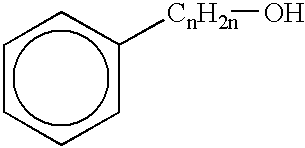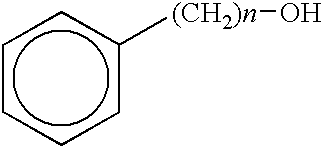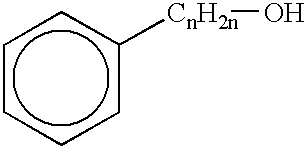Low-freezing point formulation containing phenol derivatives
a technology of o-phenylphenol and low-freezing point, which is applied in the field of low-freezing point formulations containing phenol derivatives, can solve the problems of difficult mixing of o-phenylphenol into aqueous highly concentrated pigmen, and adverse effect on the product to be protected
- Summary
- Abstract
- Description
- Claims
- Application Information
AI Technical Summary
Problems solved by technology
Method used
Image
Examples
example 1
Prior Art
A 20% by wt. solution of o-phenylphenol was prepared by dissolving o-phenylphenol in distilled water with 1.05 moles NaOH / mole o-phenylphenol.
Result
Freezing point: -3.degree. C.
The pH of the 20% by wt. solution of o-phenylphenol was 12.2 (measured at 20.degree. C.). The pH of the solution diluted to 1% actives with water was 11.8.
If the pH was reduced to below 10.5 by slow addition of diluted acid (e.g. HCl) under agitation precipitation occurred and a partially neutralized o-phenylphenol solution may be prepared, respectively. The product forms a precipitate.
The pH may not be adjusted to the value necessary for final use. The freezing point is unacceptable.
If NaOH was used a neutralizing agent it was impossible to prepare o-phenylphenol solutions with concentrations of clearly above 20% by wt. at room temperature, or they already recrystallized during storage at room temperature.
example 2
Prior Art
A 28% by wt. solution of o-phenylphenol was prepared by dissolving o-phenylphenol in distilled water with 1.1 moles KOH / mole o-phenylphenol.
Results
Freezing point: -16.degree. C., crystallization starts at -13.degree. C.
The pH of the 28% by wt. solution of o-phenylphenol was 12.6 (measured at 20.degree. C.). The pH of the solution diluted to 1% actives with water was 12.1.
The freezing point is in the proper range, however, the product is useless because of its high pH value.
If the pH was reduced to below 10.5 by slow addition of diluted acid (e.g. HCl) under agitation precipitation occurred.
The pH can not be adjusted to the value necessary for final use and it is impossible to prepare a partially neutralized o-phenylphenol solution without precipitation.
example 3
Prior Art
An aqueous slurry of kaolin from Georgia, USA having a solids content of 72.8% by wt. and a grain size distribution such that 94% by wt. of the particles had a diameter of below 2 mm (as measured by Sedigraph 5100, Micromeritics, USA) dispersed with 0.35% by wt. of sodium polyacrylate and a pH of 7.4 was preserved by 300 g actives of o-phenylphenol / t of slurry. Addition of o-phenylphenol according to example 1. (300 g actives of o-phenylphenol) / t slurry=about 1500 g 20% solution / t slurry)
A blank of the kaolin sample was prepared in the same manner but without preservative.
In the blank without o-phenylphenol a germ count of 10.sup.5 / g was measured after 24 hrs.
In the sample with 300 g o-phenylphenol / t a germ count <100 / g was measured after 24 hrs.
Upon addition of the o-phenylphenol solution of example 1 and during a storage time of 1 week, the viscosity of the kaolin slurry wit h high solids content dispersed with sodium polyacrylate immediately increased. The pH of the slu...
PUM
| Property | Measurement | Unit |
|---|---|---|
| Percent by mass | aaaaa | aaaaa |
| Percent by mass | aaaaa | aaaaa |
| Percent by mass | aaaaa | aaaaa |
Abstract
Description
Claims
Application Information
 Login to View More
Login to View More - R&D
- Intellectual Property
- Life Sciences
- Materials
- Tech Scout
- Unparalleled Data Quality
- Higher Quality Content
- 60% Fewer Hallucinations
Browse by: Latest US Patents, China's latest patents, Technical Efficacy Thesaurus, Application Domain, Technology Topic, Popular Technical Reports.
© 2025 PatSnap. All rights reserved.Legal|Privacy policy|Modern Slavery Act Transparency Statement|Sitemap|About US| Contact US: help@patsnap.com



